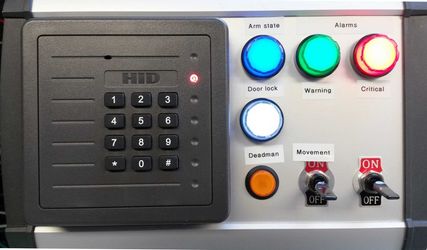...
For the remainder of this document we will use a console that includes the necessary outputs and inputs and labels to illustrate how the system works. In the following image, you can see the keypad, an arming status, two alarms to indicate the severity of the alarm status, a dead man button and a switch for simulating the motion sensor.
| Drawio | ||||||||||||||||||||||||||||||||||
|---|---|---|---|---|---|---|---|---|---|---|---|---|---|---|---|---|---|---|---|---|---|---|---|---|---|---|---|---|---|---|---|---|---|---|
|
|
Basic definitions:
- System arm status: Indicates whether the system is armed or disarmed. A disarmed system will direct the motion sensors and the door contacts to the lone worker feature while an armed system will raise an alarm as soon as a door contact is open or a motion is detected within the facility, as this is interpreted as an intrusion.
- Dead-man alerts and button: if an operator is working in a facility, there are a lot of dangers that can affect his health and even his life. Therefore, the authorities of many countries have introduced by law the need of a mechanism that identifies that the operator is alive. This is normally detected by movements inside the facility while it is disarmed. If there is no movement in some predefined time, an alarm (warning status) will be fired (switching on a buzzer or a siren) and the operator has some time to push the "dead man button", indicating that he is well. If the operator does not react in time, the alarm is escalated (critical status) and the NOC must send someone to investigate the facility in order to check that the operator is okay.
- Door lock: we use a locking mechanism that is activated through a relay. If we activate the relay, the door lock opens and the facility can be accessed. When the relay is not activated, the door is locked.
- Door contact: this is the sensor that we use to detect if the door is open or not. Ideally, a facility has one of these sensors at each and every door and window that can give access to the facility, in order to detect any unauthorized access.
- Correct code: a code is considered correct in case there is an authorized contact that has access enabled to the facility at the time the code is entered.
- Time periods: periods of time that can be configured in order that an operator have access to a facility just during a selected time frame.
...
| The diagram on the left illustrates how the current solution works, and how the status of the system depends of the inputs and outputs. In the initial state, the site/facility is armed, and no alarm is raised. After a successful entry of a valid key code, the site will switch to an disarmed status with no active alarms. The timers T1 and T2 will start to count time to the warning and critical thresholds respectively. The timers will be restarted every time a motion is detected or the dead man button is pressed, resetting the system to the disarmed/no alarms status. If the warning time threshold is exceeded by timer T1 without any motion detected or a push to the dead man button in the meantime, the site will continue disarmed, but will change its alarm to a Warning state, and wait for timer T2 for the escalation. It is advisable to configure some kind of signal, like a siren or a LED to indicate the operator that the system is in that warning state and he should press the dead man button or do some moves to trigger the motion detector. Again, if before T2 is reached a motion is detected or the dead man button is pressed, the system will return to the disarmed/no Alarms state. However, if the T2 timer is exceeded the system will change its status to CRITICAL. It is advisable to establish a protocol on the system in order that the NOC sends someone to check out the facility if the operator is still present and fine. The alarm states again will return to disarmed/no Alarms state if again a motion is detected or the button pressed (in case the worker was just taking a bit longer to reach the button than expected). Please note this is just a generic installation. The flexibility of the Automation Controller allows your company to adjust the rules regarding this configuration and add any feature that might be required. The brute force attack detection works as follows: If the system is in initial state and receives three times an invalid code, it will block the keypad and signal it with an orange light on the keypad and an CRITICAL alarm send to the NOC. After some defined time, the system will return to the initial status again. |
|---|
...
